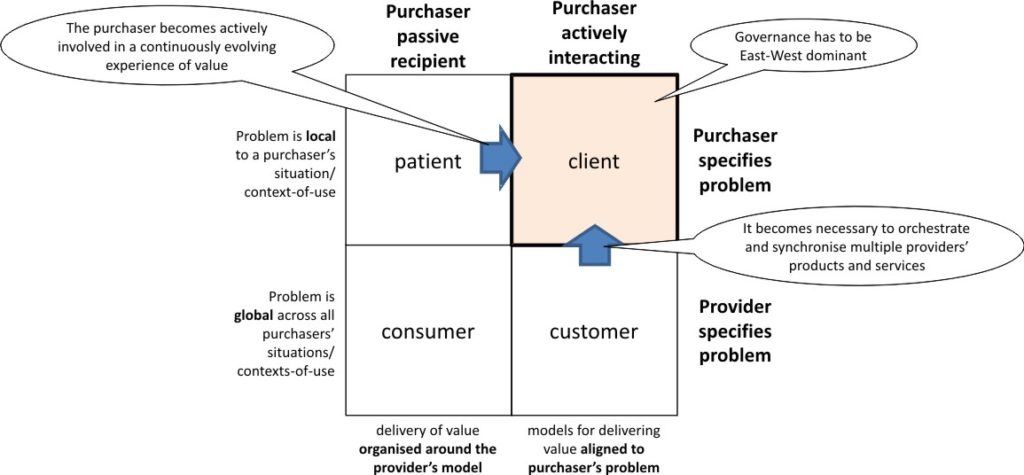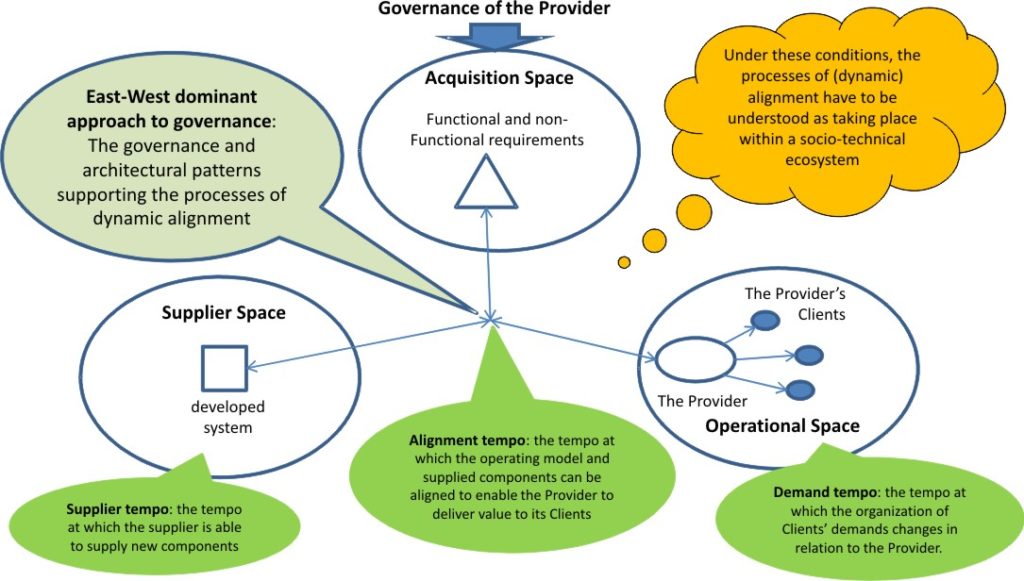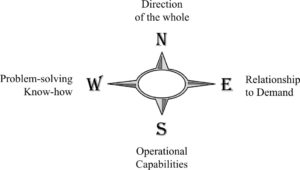by Philip Boxer BSc MBA PhD
A provider-supplier may face new challenges when it becomes actively involved in supporting a client-purchaser’s experience of value. This depends on whether or not the client-purchaser’s experience of value is dynamic i.e. on the demand tempo at which the client-purchaser’s experience of value is changing. In the following diagram this is shown as a move into the top-right-hand quadrant.
But why should this quadrant require an approach to governance that is East-West dominant? To understand this, we need to say more about ‘tempo’:

‘Tempo’ refers to the rate at which structural changes take place in the way a system relates to its environments. In the figure above, three spaces are identified – that of the suppliers, of the Provider and of Clients. Within the suppliers’ space, the supplier’s environment is their users within the Provider. Within the Provider’s operational space its environment is the multi-sided demands presented by its Clients; and within the Client’s space the environment is the context-of-use within which each Client’s demand arises. This allows us to distinguish three tempos:
- Acquisition tempo – the rate at which suppliers are able to meet new requirements.
- Integration tempo – the rate at which the Provider is able to integrate new value propositions in response to new demands from Clients.
- Demand tempo – the rate at which new forms of multi-sided demand emerge from Clients that need to be satisfactorily addressed through processes of orchestrating and synchronizing multiple products and services, including those of complementors.
The normal assumption is that the tempo of change within each space can be considered independently – the spaces can be ‘disentangled’ from each other. This allows the classical purchasing cycle in the figure below to be used. This is the framing assumption characteristic of North-South dominance, implicit in which is the assumption that the ‘design time’ of the supplier can be disentangled from the ‘run-time’ of the Provider’s operational space [1], enabling the Provider to sustain a one-sided relation to demand:

A different framing assumption is that the Provider is part of a socio-technical ecosystem, containing many systems of systems using overlapping and interlocking components, in which the way these systems are brought together has to be dynamically aligned to Clients’ needs. This is the assumption of East-West dominance – there is no ‘design-time’ that can be separated from ‘run-time’[2] because of the multi-sided nature of the clients demand that is particular to the client’s context-of-use. Under these conditions, a supplier is always adding a new component into the already ‘live’ environment of the Provider. Its supplied component cannot therefore be ‘disentangled’ from the multiple contexts in which it is to be used:

This entanglement demands asymmetric leadership of the Provider. This involves keeping a balance between four different aspects of the Provider’s behavior:

- the leadership of the organisation as a whole (North);
- the ‘agility’ of its infrastructures, i.e. the variety of behaviours the infrastructure is able to support (South);
- the variety of different ways in which the separate behaviours of the infrastructure have to be aligned to Clients’ demands, for which managers ‘at the edge’ can be held accountable (East); and
- the ways in which the Provider makes it in its employees’ interests to work in a way that is driven from the East rather than from within separate silos – including providing the means of managing alignment effectively (West). [3]
Notes
[1] ‘Design-time’ and ‘Run-time’ are ways of distinguishing a time prior to engagement with the Client during which a new proposition may be developed. ‘Run-time’ is the time within which there is a ‘live’ interaction with the Client on the basis of what has been designed.
[2] And no strategy ceiling therefore, since all aspects of the Provider’s response to the Client have to be ‘live’.
[3] ‘West’ involves a double alignment because there is both an alignment of the interests of those exercising know-how and also an alignment by that know-how of ‘South’ capabilities to ‘East’ demands.